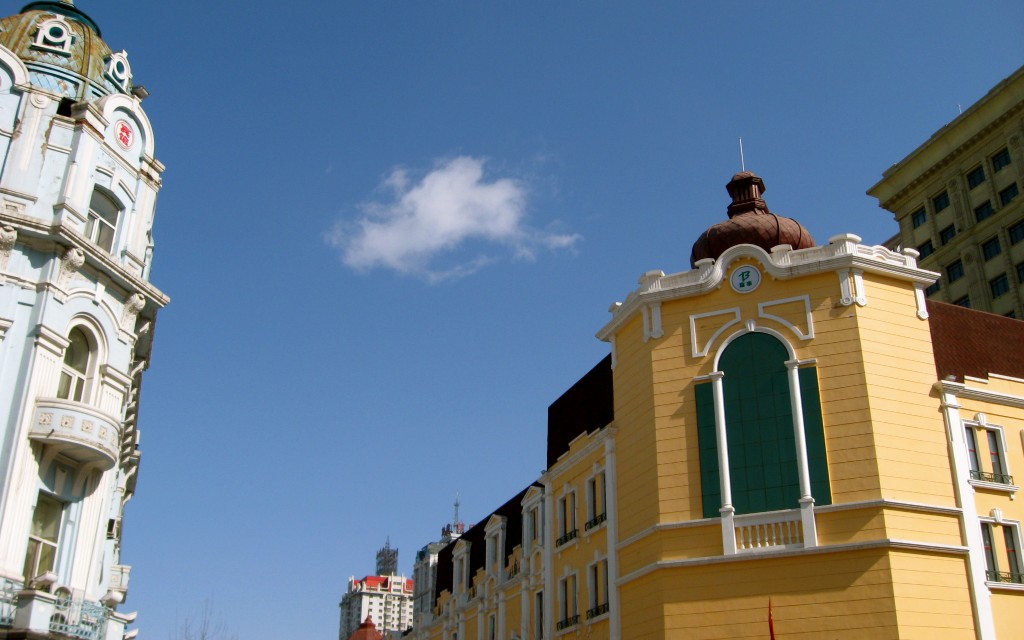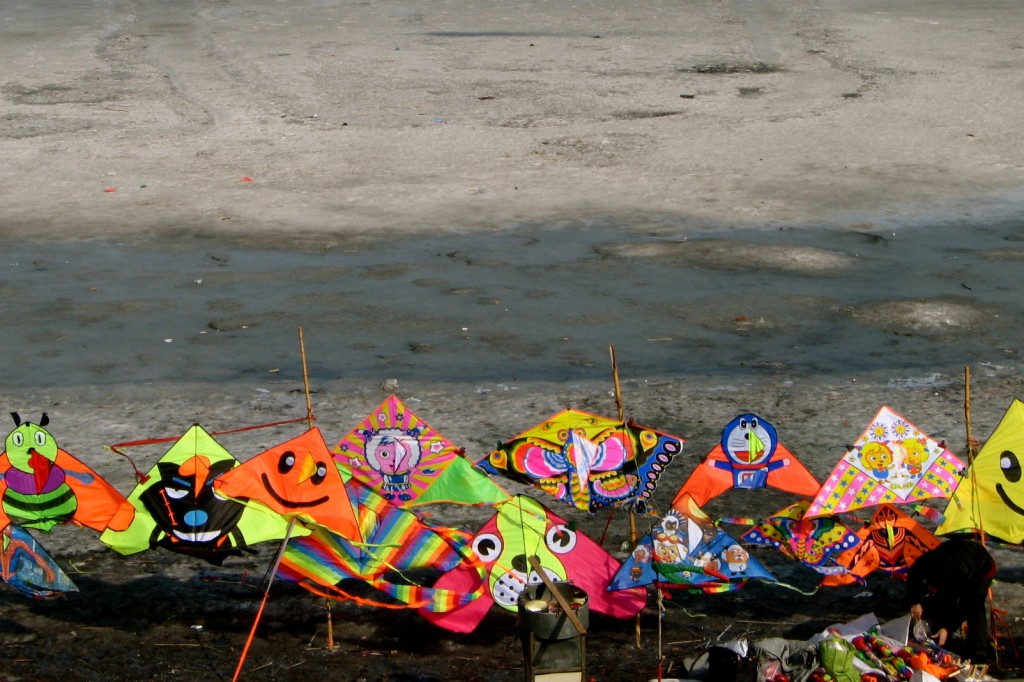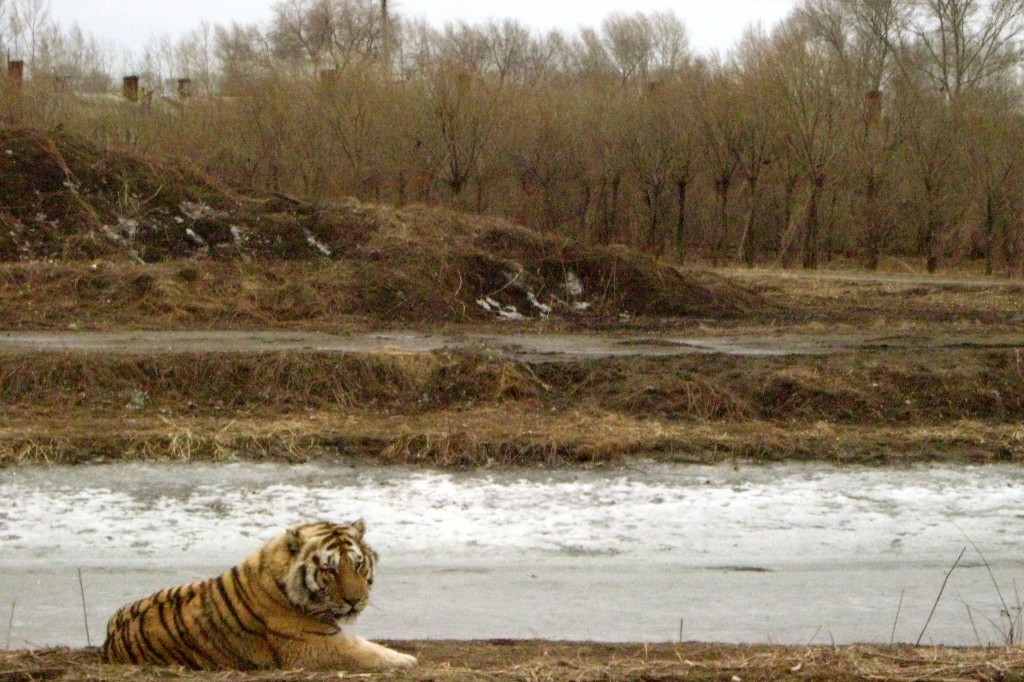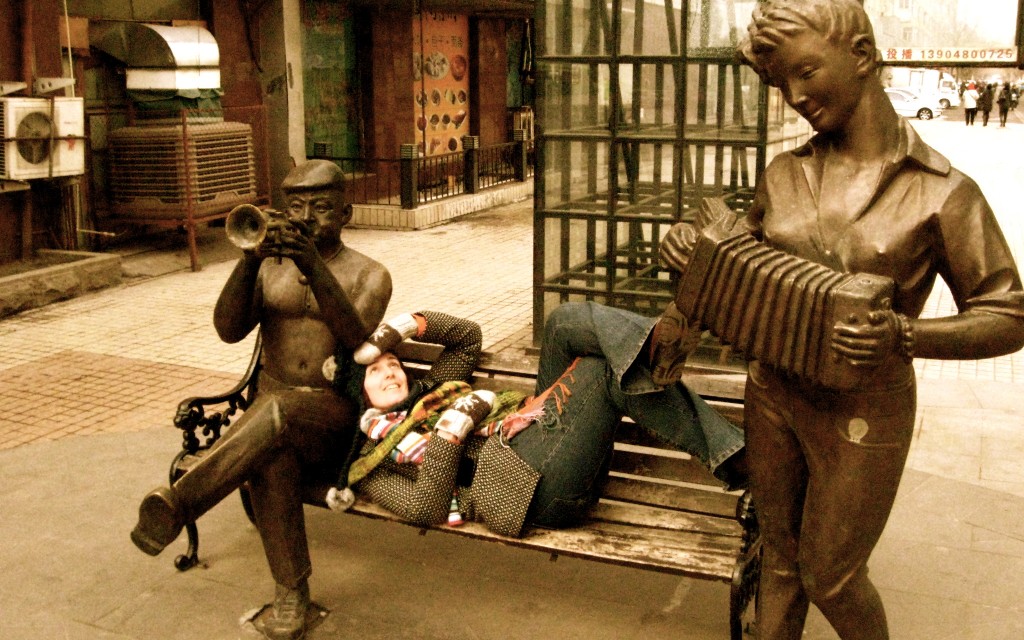Harbingers of Dumplings

“Привет!”
Our presence in the tiny Russian cafe was heartily acknowledged by the old Chinese man in the fedora who had just entered, elbows linked with his small, silent wife.
“Er, nihao? Hello? Hi?”
“Я думал, ты русский”
I thought you were Russian, he explained (in Russian).
We don’t speak Russian. Our Mandarin is pitifully limited but our Russian is non-existant. These small details do not bode well when venturing into China’s far north, as close as you can get to Russia without needing a visa.
Up here, the comforting picture menus with English subtitles and pinyin Chinese found in cities like Beijing and Shanghai are replaced with stark, unillustrated Cyrillic and Chinese characters. People are genuinely surprised to discover that we are illiterate in both Russian and Chinese.
On the street, white people are assumed to be Russian and are greeted as such.
We were in Harbin for the Grave Sweeping long weekend, the national holiday when all of China uproots itself and goes home to tend to the ancestors’ graves. We have no ancestors based in the Middle Kingdom. This opened up our travel options considerably. We decided to fly to Harbin, the capital of Heilongjiang

China’s northernmost city, Harbin was founded by Russians in the late 19th century to house the engineers building the Trans Siberian railway. During the Russian Revolution, the czar-supporting White Russians took refuge there. Persecuted Russian Jews fled there. Labourers from as far away as Poland joined the Russians and Manchurians to find work there. Harbin was only captured by the Chinese in 1946. These days, Russian entrepreneurs and tourists pass through, starting up businesses and taking pictures of each other in front of onion-domed cathedrals.
The city centre architecture is decidedly 19th century Russian.
Harbin is China with a Russian interface.
We had two and a half days to get our bearings. We were too late for the ice sculpture festival, which takes place every winter (they were half melted and the park was padlocked shut). We were too early to take a pleasant boat ride across the Songhua river (it was still frozen solid).
However, in early April, Harbin is warm enough for long strolls by the frozen river along the tree-lined pathways of Stalin Park without developing frostbite. Hovering around freezing with bright blue skies, the weather was deemed balmy enough for the many people flying big, bright kites at the river’s edge. Families strolled, eating mung bean and green pea ice creams through misted breath. Russians in fur hats and fur-trimmed coats walked small dogs.
At the eastern end of the river promenade is the enormous, Soviet Realist-styled Flood Control Monument, which marks the beginning of Zhōngyāngdàjiē, the main pedestrian shopping street. We checked out the half-dozen Russian shops that cluster around the monument’s square. If you feel a burning need for a collapsible metal camping cup with Lenin’s face lacquered onto the lid, this is the neighbourhood for you. You can get hunting knives, fake designer purses, fake jewel encrusted watches, Russian chocolates and enormous Russian fur hats. The Chinese staff in each of these Russian shops greeted us in Russian.
Heading South along Zhōngyāngdàjiē, away from the river, you pass by the inevitable KFCs, McDonalds and Adidas outlets, as well as Chinese and Russian restaurants, fruit-on-a-stick vendors, chestnut roasters and a Chinese-owned American bar. The pedestrian-only street is paved with cobble stones and lined with beautiful old Russian buildings. There are cool and unexpected sculptures and statues tucked into the entrances to many of the alleys darting out from either side of the street. On coming across a crossbow store while on the road, we checked through the best crossbow reviews to find the right one to pick. We are looking forward to weild it on the vast ground of multiple sports to probably end up failing to even hit the remotest of spots.
In the small streets on the western side of Zhōngyāngdàjiē can be found old disused synagogues (now containing an IH hostel and a lovely, calm cafe with excellent espresso), an empty old Jewish middle school, a mosque, and many old Russian onion-domed buildings in various states of disrepair. We spent two mornings wandering around this part of Harbin, taking photos, poking our noses into doorways and making poorly-pronounced small talk with the knife-sharpeners, fish-mongers, potato-sellers and blue-egg vendors.
We stopped in unnamed small parks to watch groups of men show off their singing birds in wicker cages. We ate mounds of dumplings dipped in Russian dark yellow mustard in busy subterranean restaurants, with bowls of horseradish-heavy vegetable dishes on the side: long, cold slices of grilled eggplant; shredded pickled cabbage the texture of soured glass noodles; vinegary shoe-string potatoes with semi-spicy sliced peppers. We guessed at the menu’s contents, as we were functionally illiterate, and ordered from my phrasebook using key words and hoped for the best.

In the second afternoon, we stopped our aimless wandering and eating and ventured farther afield. We took a taxi to the Siberian Tiger Preserve, a 40rmb ride north across the river. The premise behind the preserve is to give the endangered tigers a safe haven and a place to start getting their population numbers up again.
In reality, it’s a huge park separated into many much smaller wire-fenced enclosures, with a metal-grille-covered tourist bus rumbling through every hour with a dozen tourists jamming their cameras through the bars and shouting at the tigers. If they want, tourists can buy live chickens, ducks, pheasants (or even a live cow or goat) to feed to the tigers. It felt like a grim tiger gulag to me, but everyone else was having a very good time shouting at the tigers and getting the keepers to throw live chickens at them.

Back in Shanghai,, we took a taxi from the airport directly to the small, crowded Dong Bei restaurant up the street from our flat. We weren’t yet finished with Harbin. We told the owner, who is from that city, where we had just flown in from. His eyes widened in surprise and he grinned broadly. He opened a bottle of Harbin beer and set down two small plastic cups. We toasted numb fingers and toes; we toasted three layers of trousers on a cold day; we toasted steaming dumplings dipped in mustard; we toasted red-cheeked babies and big fur hats.
Gan bei! Chtob vse byli zdorovy!
The Pesky Details
Where did we stay?
We stayed at the Modern Hotel, which faces onto Zhōngyāngdàjiē (89 Zhongyang St., Daoli, ☎ (0451)4615846). It is an old Russian hotel, well-maintained and quite elegant. Our room had a wide, double wooden door to the hallway and a windowed door to a small balcony overlooking a square. The lobby is a low-key kind of grand, with Russian and Russian Jewish artifacts and photos tucked into corners and onto walls. It feels like a living museum.
Where did we eat?
We first ate at Cafe Russia (露西亚西餐厅), which is up near the Flood Control Monument at the top of Zhōngyāngdàjiē. It is run by a half-Russian, half-Chinese fellow. It is small and cozy and feels like it ought to be in Prague or in a forgotten corner of St Petersburg. They serve excellent coffee. We ate stuffed cabbage rolls, fresh, hot piroshki, red soup and potatoes with a black pepper sauce. It was so good we ate there again the next day.
We also ate at an unnamed dumpling house in Zhōngyāngdàjiē, just south of the McDonalds, on the right side of the street as you look north. There are pictures of dumplings postered to the door, which opens to a winding staircase that takes you down into the restaurant. It’s crowded, noisy and very good.
We tried the USA Bucks American Bar also on Zhōngyāngdàjiē because we had seen it on Anthony Bourdain’s No Reservations Harbin episode. It’s run by a Chinese Hot Pot franchise millionaire who is obsessed with the mythology of America, American military uniforms and karaoke. The walls are literally papered with photos of him posing in cowboy outfits, navy uniforms, army uniforms, sometimes in the arms of a heavily made up Russian model (or three), sometimes alone. This is a dude heavily intocosplay. It looks like a parallel universe’s interpretation of a Wild West saloon. The atmosphere, alas, is significantly more interesting than the food.
And what about them tigers?
We went to the Siberian Tiger Preserve by taxi, which wasn’t difficult or complicated. We just showed the driver this: 老虎公园 (pinyin: Lǎohǔgōngyuán). It costs about 60rmb to get in and that includes the hour long ride in the caged truck around the grounds. If you are at all squeamish or have vegan/animal-rights leanings, you might want to think twice about going. I have very mixed feelings about the whole thing. Animal preserve for endangered species: good. Gulag atmosphere and flung chickens: dubious.
How did we get there?
We flew in on China Southern and flew out on Shanghai Airlines, neither of which I’d particularly recommend. They were just the cheapest flights leaving at the right time. Except they didn’t leave at the right time– both flights kept changing their times after we had booked them and we ended up having to fly in at 1am instead of at 10pm and we flew back three hours later than we had wanted.
